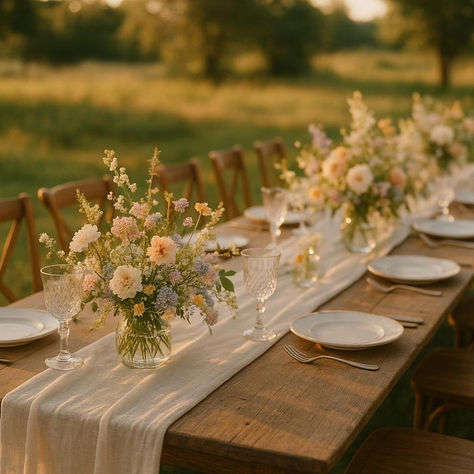Ultimate Guide to Vendor Communication for Weather Changes
- Colin
- Apr 1
- 6 min read
Updated: Apr 8
When unexpected weather strikes, clear communication with vendors can save your event. Here's how to prepare:
- Plan Ahead: Create weather backup plans, including indoor venues, tents, and temperature control equipment.
- Coordinate with Vendors: Set clear deadlines, monitor forecasts, and establish a vendor alert system for real-time updates.
- Adapt Quickly: Be ready to adjust schedules, food service, and setups on the event day.
- Evaluate Post-Event: Review vendor performance to improve future planning.
Key Tip: Assign a lead contact to handle all weather-related updates and use reliable tools like group messaging apps for fast communication.
With these steps, you can ensure smooth vendor coordination and keep your event on track, no matter the forecast.
34 - Wedding Backup Plans
Weather Backup Plans
Work with your vendors early to prepare for bad weather. This helps avoid last-minute issues and keeps things running smoothly.
Venue Backup Spaces
Having indoor spaces ready is key for outdoor events. For example, at Alamo Wedding Venue & Events Center, events in their stunning limestone courtyard can easily move indoors if the weather turns. When planning, keep these points in mind:
- Check capacity: Make sure the indoor space can fit all your guests.
- Plan the transition: Know how long it takes to switch from outdoor to indoor setups.
- Set triggers: Decide what weather conditions will prompt the move indoors (e.g., rain forecast).
- Confirm logistics: Ensure lighting and power are ready in the backup area.
- Review costs: Ask about any additional fees for using indoor spaces or temporary structures.
These steps ensure your venue is ready for any weather surprises.
Weather Protection Equipment
Secure your equipment rentals in advance to avoid scrambling later. Here’s what to plan for:
- Tents
- Choose the right size for your guest count.
- Consider seasonal weather when selecting the type of tent.
- Plan the setup and breakdown schedule.
- Check for power and lighting needs.
- Ensure the tent is securely anchored.
- Temperature Control
- Use industrial fans for airflow.
- Rent portable AC units for hot days.
- Have outdoor heaters ready for chilly weather.
- Consider misting systems for cooling.
- Guest Comfort
- Offer market umbrellas for shade.
- Provide rain umbrellas at guest stations.
These items help keep your guests comfortable and your event on track.
Food Service Weather Plans
Work with your caterers to create flexible food service options that can adjust to the weather. Here are some examples:
Weather Scenario | Food Service Adaptation |
Sudden Rain | Move to covered buffet stations. |
Extreme Heat | Use refrigerated displays for perishable items. |
High Winds | Secure equipment and use weighted linens. |
Cold Weather | Offer hot beverage stations and warm food holders. |
Additional food service tips:
- Station Mobility: Make sure serving stations can be moved quickly.
- Temperature Control: Use proper equipment to keep food at safe temperatures.
- Extra Staff: Have enough servers to handle changes.
- Food Safety: Plan for safe food handling during transitions.
- Beverage Stations: Set up portable bars that can move if needed.
Weather Update Schedule
Plan a timeline to monitor weather conditions and keep vendors informed, ensuring timely and well-coordinated actions.
Weather Check Points
Regularly monitor weather conditions and adjust plans as needed:
Timing | Action Items | Communication Focus |
30 Days Out | Review long-range forecast trends | Notify vendors of initial plans |
14 Days Out | Monitor detailed forecast patterns | Discuss equipment and setup needs |
7 Days Out | Track hourly forecast updates | Confirm backup plans |
72 Hours Out | Assess short-term forecast data | Finalize adjustments |
24 Hours Out | Monitor real-time radar updates | Make final decisions |
For outdoor venues like the Alamo Wedding Venue & Events Center, use multiple forecast sources to ensure accuracy and smooth planning.
Backup Plan Deadlines
- 48 Hours Before: Finalize tent arrangements
- 36 Hours Before: Confirm venue setup
- 24 Hours Before: Deploy heating or cooling equipment
- 12 Hours Before: Set up weather protection measures
- 6 Hours Before: Complete all equipment installations
These deadlines ensure vendors have enough time to adjust, with catering teams requiring at least 24 hours' notice for any setup changes.
Vendor Alert System
Keep vendors informed with a dedicated alert system:
- Primary Communication ChannelUse a group chat or email thread for updates. Include all key vendors and set clear expectations for response times.
- Update ScheduleShare structured updates with the following details:
- Current forecast
- Potential weather changes
- Vendor-specific action items
- Timing for the next update
- Emergency ProtocolEstablish a rapid response plan with a designated coordinator, clear vendor timelines, and specific signals to activate backup plans.
Vendor Communication Methods
Once backup plans and update schedules are in place, keeping vendors informed during sudden weather changes becomes crucial. Clear communication protocols help ensure everyone stays on the same page and can respond quickly.
Lead Contact Role
Assign one person to handle all weather-related communication with vendors. This role involves:
- Acting as the primary decision-maker and communicator for weather updates.
- Working directly with venue staff and weather services to gather accurate information.
- Keeping detailed records of all communications and addressing vendor concerns promptly.
This centralized approach ensures consistency and avoids confusion.
Communication Tools
Set up a reliable system using multiple channels:
- Event management platforms for official updates and announcements.
- Group messaging apps for quick back-and-forth communication.
- A dedicated emergency line for urgent or critical updates.
Each tool serves a specific purpose, ensuring vendors receive updates without delay.
Weather Response Plans
Develop clear action steps for different weather scenarios to guide vendors effectively:
1. Standard Conditions
- Define baseline procedures for normal weather.
- Set routine operating protocols.
2. Moderate Weather Changes
- Specify adjustments for setup, equipment protection, and services.
- Include timelines for responding to these changes.
3. Severe Weather Response
- Identify triggers for activating backup plans.
- Detail immediate actions to protect equipment and ensure guest safety.
- Provide specific safety measures for severe conditions.
These plans give vendors clear instructions, enabling quick and coordinated responses when weather conditions shift.
Same-Day Weather Changes
Weather changes on the day of an event can throw a wrench into your plans. Quick communication and a solid backup strategy are essential to keep things running smoothly.
Schedule Adjustments
If the weather forces you to tweak your timeline, here are a few ways to handle it:
- Reorder Activities: Shift activities around to take advantage of better weather. Adjust vendor arrival and setup times, and schedule breaks when conditions improve.
- Add Buffer Time: Include 15–30 minute gaps between segments to allow for quick adjustments. Have indoor options ready for weather-sensitive activities, and create a shorter version of your schedule just in case.
- Work Closely with Vendors: Keep your vendors in the loop about any changes to delivery, setup, or breakdown times. Adjust service schedules, like food or entertainment, to fit the new timeline. If equipment needs to be moved, coordinate quickly to stick to the revised plan. Staying aligned with vendors ensures everything runs as smoothly as possible.
After-Event Review
Post-event analysis is crucial for improving vendor communication strategies and preparing for future weather challenges.
Vendor Weather Response
Assess how vendors handled weather-related adjustments by focusing on these key areas:
- Response Time: Measure how quickly vendors acknowledged and acted on weather alerts.
- Flexibility: Observe their ability to adjust services and setups as needed.
- Communication Quality: Review how clear and frequent their updates were.
- Problem-Solving: Note creative or effective solutions they implemented.
To make this process easier, use a structured evaluation form for each vendor:
Assessment Area | Rating (1-5) | Notes |
Alert Response Time | _ | Document specific instances |
Equipment Adaptability | _ | List weather-related adjustments |
Staff Preparedness | _ | Note coordination and readiness |
Communication Clarity | _ | Record frequency of updates |
Guest Experience Impact | _ | Include examples of feedback |
These evaluations can help you refine vendor contracts and ensure better preparedness.
Contract Updates
Based on your recent experiences, consider revising vendor contracts to address weather-related scenarios more effectively:
- Add specific conditions that activate backup plans.
- Set clear timelines for weather-related updates.
- Include detailed equipment protection measures.
- Outline staffing expectations for severe weather situations.
- Clarify cost adjustments for weather-related changes.
Vendor Recognition
Use updated contracts and evaluations to strengthen relationships with top-performing vendors:
- Provide detailed feedback, highlighting their successful efforts.
- Consider creating a preferred vendor program for those who consistently excel in weather-related situations.
- Share positive experiences with your planning team to build trust and encourage collaboration.
Conclusion
Strong vendor communication during unpredictable weather is key to pulling off a successful event. The strategies we've covered - like setting clear backup plans and using effective communication tools - lay the groundwork for a dependable plan to handle weather challenges.
Take the Alamo Wedding Venue & Events Center in Mason, TX, for example. Their mix of indoor and outdoor spaces, including a limestone courtyard, ensures smooth transitions when the weather takes an unexpected turn. This shows how effective vendor coordination can help events adapt quickly.
Here are three key elements to focus on:
- Planning Ahead: Set weather checkpoints, backup deadlines, and response protocols well before the event.
- Clear Communication: Use designated contacts and unified tools to keep everyone on the same page.
- Ongoing Evaluation: Review vendor performance and adjust protocols based on real-world experiences.
By adopting these approaches, you can create a vendor communication plan that stands up to weather challenges. Venues like Alamo Wedding Venue & Events Center make it easier to manage vendor coordination and execute backup plans efficiently.
The secret to success is treating weather preparedness as an ongoing effort. Regular updates to contracts, improved communication systems, and strong vendor relationships will keep your events running smoothly, no matter the forecast.











